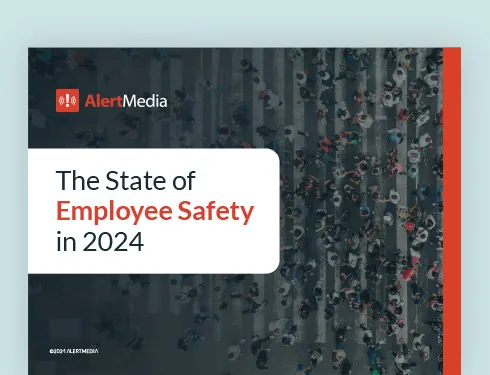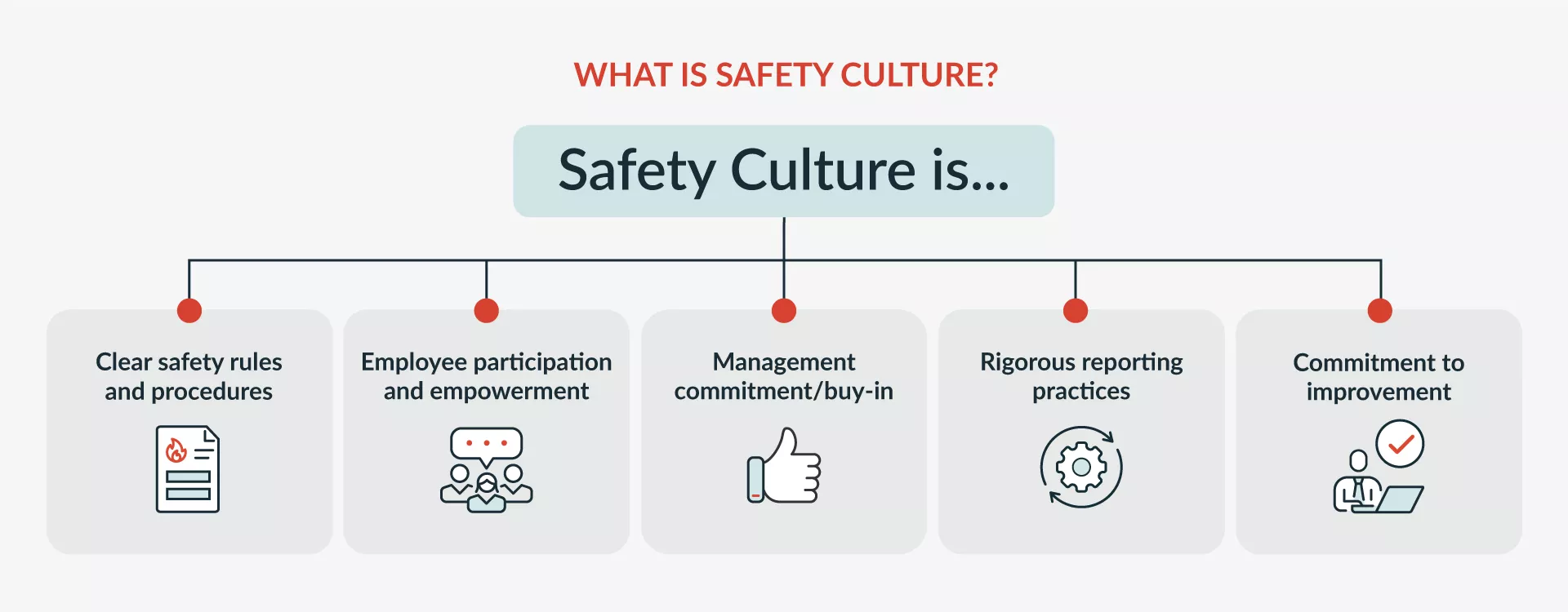
3 Examples of Companies With Great Safety Culture
Creating a good safety culture is difficult, but luckily we can learn from others’ success. Here are some examples of AlertMedia customers who have great safety cultures, and some insights into how you can develop one of your own.

Your organization is a complex web of people, functions, systems, and customers. If any of those connections fail, it can cause cascading problems throughout the business. Disruptive events, such as extreme weather and accidental injuries, can throw a wrench into your operations and, if not adequately prepared for, can have disastrous consequences.
How, then, is an organization with hundreds or thousands of employees reasonably expected to prevent any possible breach in occupational safety? There’s no crystal ball required, only an understanding of the importance of an organization’s safety culture.
We recently spoke with several AlertMedia customers to learn more about their approach to fostering a strong safety culture, and in this post, we’ll discuss how you can emulate their success.

Download Our 2024 Employee Safety Report
What Is Safety Culture?
Simply put, an organization’s workplace safety culture (sometimes called “safety climate”) describes the values, priorities, beliefs, and ideals individual members of that organization express relating to staying safe, as well as how those ideas propagate throughout the organization. It is part of the larger company culture, which you might characterize as the collective work practices and overall “feel” of a business.
This attitude toward safety is a good indicator of the kind of outcomes an organization can expect from their safety practices. Companies that engender thoughtful, aware, and confident mindsets toward safety issues among all of their employees are far more likely to resist the negative impacts of safety issues and are less likely to even encounter those problems in the first place.
Creating a safety culture is important because it allows all of your people to become safety leaders. Suppose they see something unsafe happening and are empowered to speak up and offer solutions. In that case, your people will be able to self-correct looming safety problems before they happen instead of relying on designated safety leaders to notice any potential disruptor.
Negative safety culture
We’re going to focus on examples of positive safety culture today since we believe that they offer much to learn that can be applied to any organization. However, it’s important to recognize the signs of a negative safety culture. Those include, but are not limited to:
- A lack of documented safety procedures
- Confusion about safety issues among employees
- A prevalence of anger and blame instead of reflection and improvement
- Employees working in conditions they know are dangerous
- Faulty or absent personal protective equipment (PPE)
- Prioritizing productivity or profits above people
3 Examples of Great Safety Culture From AlertMedia Customers
AlertMedia is lucky to have so many customers focused on creating safe work environments for their employees, clients, and partners. We’re excited to share some of their insights with you. Some of those customers have provided their thoughts on their own examples of effective safety culture as well as advice to other organizations hoping to emulate their success.
Dalkia Energy Solutions, Texas Roadhouse, and Moss Construction are all committed to developing the perfect safety culture for each of their businesses. However, that doesn’t mean that each of their safety plans are the same. As a restaurant chain, Texas Roadhouse’s needs, concerns, and safety policies differ significantly from Dalkia, an energy company. But these organizations share a common belief in the importance of safety and are all in agreement that creating and maintaining a healthy culture of safety and encouraging the exchange of safety information is crucial to running a resilient business.
Read on to learn more about how each of these organizations thinks about safety culture in their own words.
Q: What does “safety culture” mean to your organization?
Mark French, Dalkia Energy Solutions, says: “Dalkia uses the term “zero harm” to describe their safety efforts. It is a wonderful phrase that sums up what I feel my goal is as a safety professional. I am not here to prevent OSHA recordables, lower lost time rates, or lower workers’ compensation costs. Those are great outcomes, but the real mission is to prevent any harm to my team, to the environment, and to the clients and communities that we service. Dalkia has a distinct focus on culture, not just on safety. It is a culture that is focused on people which means empowerment, inclusion, and a safe place to work.”
Matt McMahan, Texas Roadhouse, emphasizes the importance of adapting to the given situation: “The meaning of safety culture will differ depending on the circumstances. When referring to operational safety, it can mean daily awareness and frequent communication. In terms of safety management, the signs of a safety culture can mean the attention around identifying and determining appropriate treatment for the identified risks.”
Q: Why is safety important to your organization?
Mark, Dalkia: “Safety is the first step in showing our team that we truly care about their wellbeing. Without that sense of safety, we are not doing our part to motivate and fulfill our team members fundamental needs as humans. Dalkia prides itself on having innovators with a great sense of collaboration. Without a focus on safety, the feeling of team begins to erode. The goal of our organization is to preserve and encourage a culture of teamwork and belonging.”
Matt, Texas Roadhouse: “No one wants to be injured or have someone else be injured, so the desire to create and sustain a safe environment comes naturally. And Texas Roadhouse’s mission is to provide Legendary Food, Legendary Service®. Neither of those goals can be achieved in an environment where guests, vendors, or employees feel unsafe.”
Q: How has your organization improved its safety performance and safety culture?

Matt, Texas Roadhouse: “We’ve focused on making improvements each year and obtain ideas from across the organization. The result is improving documentation, metrics, technology, and innovative ideas. Above all, [it comes down to] good communication. An organization can have industry-leading tools, but outcomes will be mediocre without solid, memorable communication practices.”
During an episode of our Employee Safety Podcast, Scott Gerard, VP of Environmental Health and Safety at Moss Construction said: “I think the key for us has been to involve our [employees] in charting the course of the organization. We got them involved very early on when we were establishing the culture here.”
Q: What is the most challenging part about building and maintaining a culture of safety?
Mark French, Dalkia: “Communication is always the most difficult part of maintaining a [safety] culture. Even when it feels like there is overcommunication, it is still not enough. It is important that there is an opportunity for open communication across all levels of the organization. The long-term goal is to have layers of communication where there is a constant cycle of ideas and feedback.”
Matt, Texas Roadhouse: “The biggest challenge is to start. Each organization will have unique challenges from an operational and communication perspective that cannot be met with a cookie cutter approach. For those starting out, the steps needed to create a safety culture can seem overwhelming. I think it’s important to remember the quote, ‘No one is great to start, but you have to start to be great.’”
Q: What advice do you have for other organizations that are trying to improve their safety culture?
Scott with Moss Construction was quick to say how important it is to loop in the right people: “I think [improving safety culture] is easy. I think you just go the front line and ask. Get the workers involved; they’ll give you the best feedback. They know where the risk is; they know where the challenges are. It shouldn’t be a mandate coming from on high.”
Matt at Texas Roadhouse encourages us to absorb knowledge from colleagues and peers: “Don’t be afraid to ask for help. And take opportunities to network and learn from others in the industry, including leveraging great vendor partners.”
Q: What specific preparation was the most useful to you in 2021?
Matt, Texas Roadhouse: “During the pandemic, we invested in a technology that helped manage daily symptom surveys for our employees. Having this technology in place was key in doing contact tracing, communicating with local health departments, and creating a safe environment for guests and employees.”
Mark, Dalkia: “As I traveled frequently for work, having the AlertMedia warning system was so valuable. I knew that I would be made aware of changing situations no matter where in the USA I was traveling. There were a few times that I actually made changes in my travel due to weather alerts and predictions that the application warned me of.”
Q: What will you be adding to your emergency plans?
Mark, Dalkia: “The Dalkia focus is on being better prepared while we are at client sites. Our team should be empowered to know the hazards they could face, where to evacuate to, how to get help, and client-specific protocols for reacting to emergencies.”
Matt, Texas Roadhouse: “AlertMedia makes handling mass communication easier than any other tool we’ve used. Being able to accurately create distribution lists and send messages to hundreds or thousands of individuals over multiple channels is a difference-maker, which frees our crisis team to focus on the messages being sent rather than mechanical issues such as channels and distributions lists.”
Q: How have your emergency communication efforts progressed now that you use AlertMedia?
Mark, Dalkia: “There is a good piece of mind in knowing that help is only a button away. When someone travels frequently, it is hard to keep up with your exact location. Having the GPS tracking and the ability to get help when it is needed no matter where someone is located is a powerful tool.”
Matt, Texas Roadhouse: “We are focusing on summarizing comprehensive plans into one-to-two page reference guides. This will give crisis responders a framework to refer to when there isn’t time to dig through a detailed and lengthy plan.”
3 Ways To Improve Your Own Safety Culture
From these responses, it’s clear that developing and maintaining a good culture of safety is a crucial and multi-faceted pursuit. Safety training sessions alone isn’t enough to build a successful safety culture — it has to be something that is ingrained in each of your employees, no matter what they do.
Step 1: Make time for planning
We’ve heard how planning is an absolutely critical part of safety culture. Since these organizations are thoughtful and proactive about the risks associated with their operations, they’re able to predict what problems might arise and create plans to avoid or mitigate their effects. Without those strong cultures of safety, planning ahead might not have been as high on their lists of priorities, and they would have become reactive instead of proactive.
Unfortunately, it’s not possible to plan for everything. Complications like unforeseen weather events, social upheaval, or run-of-the-mill human error can throw a wrench into your plan. Be ready to shift to plan B or improvise, don’t be married to a plan that isn’t working in a particular scenario. Implementing an incident reporting system can help you respond to this issue should it arise again.
Step 2: Involve everyone
Some leaders tend to issue commands in a top-down manner, but that can damage safety culture and safety programs. While senior management buy-in is important, the companies we spoke with each implore other organizations to solicit feedback from the people who are actually responsible for implementing safety measures. After all, they’re the ones who have hands-on experience with the issue, and ignoring their competencies or their safety concerns during decision-making can hurt both your safety culture and safety outcomes.
By hearing out those who are implementing safety procedures on the ground, you set your organization up to do better next time, and to pursue continuous improvement, and culture change if necessary. If you’re looking for a method to structure this, a great way to analyze your performance is with an after action report.
Step 3: Use technology to scale
The final commonality between our conversations with our customers is that each of them recognizes the value of using emergency communication software to make sure everyone’s on the same page. A true emergency-grade multi-channel emergency notification system can make all the difference in the confusion and chaos of a crisis.
It’s clear that cultivating a positive safety culture is a boon to achieving all other safety initiatives. Do you have thoughts on your own safety culture you’d like to share with us? Drop us a line on Twitter or email thesignal@alertmedia.com.




